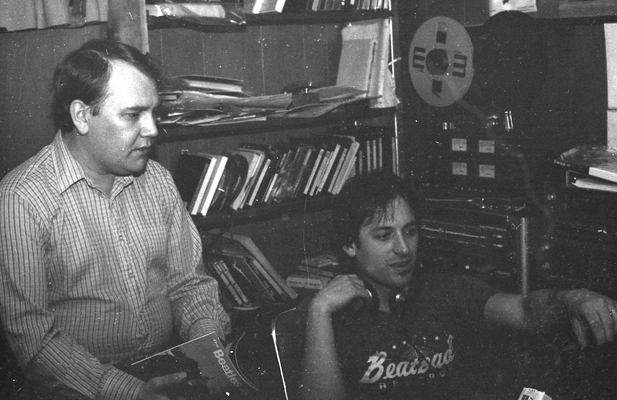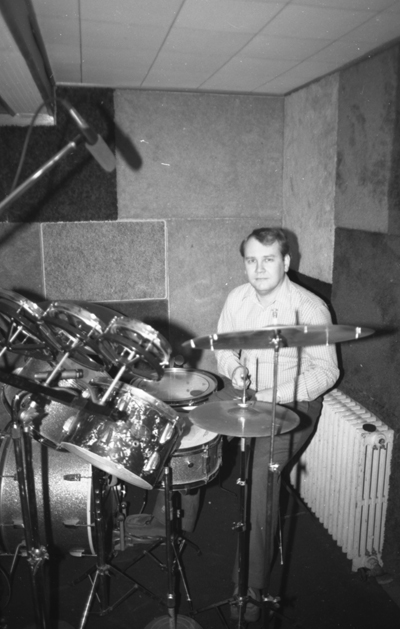
BILL KERN BIOGRAPHY - Page 2
In 1976, Bill and Barry began recording
their own versions of the famed Songs that Lennon & McCartney gave
away. Many of these songs had been recorded by groups whose sound was
very different from that of The Beatles. What Bill and Barry attempted to
do was recreate the raw energy of the early Beatles recordings. In 1978,
they began working more seriously on this project. Bill had a Dutch import
of The Strangers with Mike Shannon's recording of One and One Is Two,
which they felt was a very unflattering version of what could be a great rock
& roll tune in the spirit of I Saw Her Standing There. Barry
had a piano score for Tip Of My Tongue from a Hal Leonard Easy Piano
edition of a Lennon McCartney Song Book. They knew, as most hard-core
Beatles fans do, that these were two of the most obscure songs from the
Lennon/McCartney catalog. On the way to the studio, Bill bought a
harmonica, thinking it would be effective on one of the songs because The
Beatles used harmonica on many of their early recordings. They also
invited John Sheridan to play drums for the session. John had been in a
band with Bill a few years earlier, and was also an avid Beatles fan who, unlike
most drummers at the time, admired and respected Ringo's drumming, and knew many
of his drumming nuances. The results of this session were so good, that
Bill and Barry felt compelled to release these two songs as a single, knowing
that they would be the first U.S. releases of both of these songs. They
approached Jim Antonucci (Nippo), owner of Death Records (the label that
released Barry's solo single, Baby Don't Give Up), but he turned it down.
At this point, I have to take you on a
little side bar... Bill Kern and Barry Knoedl, along with Ralph Mori ran a
record store in Bayshore, NY, selling collectible oldies and British
Imports. The name of this store was Beat Bad Records, for the first letter
in each of their names. There's more to the story of that name, but it is
long and too much of an inside gag to explain here. When Bill and Barry
were ready to release Tip of My Tongue and One And One Is Two, it occurred to them
that they needed a group name. They tossed a lot of names around, keeping
in mind that The Beatles chose their name because of its double meaning.
They tried a lot of names with the word BEAT in them. It suddenly occurred
to them that Beat Bad Records had the word BEAT in it. Almost
simultaneously they both said, "turn it around - The Badbeats!" Now
they had a record and a group name, but no one to put it out. After
careful consideration, and some encouragement from their business partner, Ralph
Mori - who was becoming more involved in the operation of their recording
studio, they decided to release it on their own label, which would obviously be
called Beat Bad Records.
 |  | |
Bill & Barry in the studio in 1981 |
Bill at the drums |
With the most important ideas settled,
they began working on the particulars. What should the record look
like? How do we market this record? Many of the specifics were
settled on quickly and easily. The nostalgia market was hot at the time
because the 25th anniversary of The Beatles first visit to America was fast
approaching. It was decided to model the picture sleeve after the early
1960's Capitol Records picture sleeves. It was also decided early on to
shroud the group in mystery. None of the band members names appeared on
the record, picture sleeve, or any of the promotional material accompanying the
release. Bill and Barry were credited as producers, and represented the
group in the few interviews given after the release. Even the picture on
the sleeve, done in the style of Meet The Beatles (With The Beatles), obscured
their faces. Ray Knoedl, Barry's older brother was included in the picture
even though he does not perform on the record, although his appearance was
almost prophetic, as he performed on many of Bill and Barry's later recordings,
including Tell Her No and Lies, The Badbeats'
second single. When it came time to design a label for the record,
everyone felt it would be a nice touch if we could recreate the early 1960's
Capitol Records label, which every long time Beatles fan would recognize.
Knowing Capitol's track record with bringing suit against people who infringe on
their trademarks, we set about obtaining permission to use the label design for
this record. After sending a complete mock up of the record, clearance was
given to use the Orange and Yellow swirl design for this release only, provided
we modified the Beat Bad Records logo, which originally resembled the Capitol
Records logo more closely. It was fortunate that we did this, because both
the label printer, and the record manufacturer required copies of the letter
from Capitol before they would provide services to us.
We also had to get a mechanical license
from ATV/MACLEN Music, The Beatles' U.S. publisher at the time, to use the
songs. It was then that we confirmed that these songs had never been
released in the U.S. The librarian at ATV asked Barry how he even knew
these songs existed. Although they had a file on both songs, they were
completely blank, meaning there were no prior requests for licenses.
|



